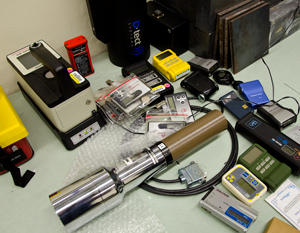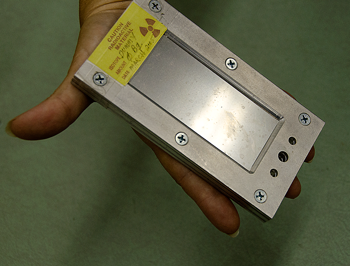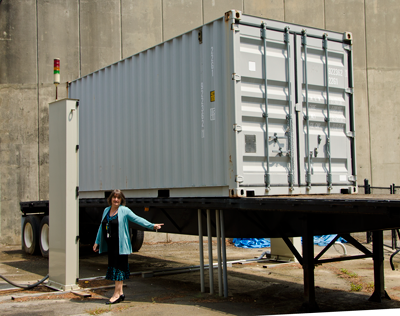
Some of the kinds of radiation detectors affected by the new standards.
PML researchers played a central role in the establishment of new testing and evaluation (T&E) standards for radiation and nuclear detectors about to be adopted by 22 federal agencies.
The standards, now in the final stages of approval, cover a range of devices from personal-detection equipment to hand-held radionuclide identifiers for field use and portal monitors for vehicles and cargo containers.
Users of the equipment are military personnel and the Department of Defense, Federal and State first responders, and others from agencies including the Department of Homeland Security (DHS), the Food and Drug Administration, the Centers for Disease Control and Prevention, the Environmental Protection Agency, and the National Institute of Occupational Safety and Health.
"For people using this type of equipment" says Dr. Lisa Karam, Chief of PML's Radiation and Biomolecular Physics Division, "knowing that the detectors' performance is reliable and 'fit for purpose' is absolutely necessary for their confidence that the results they get are reliable."

The new standards are the first of a planned total of eight to be issued by an interagency panel, the Department of Defense (DoD) Test and Evaluation Capabilities and Methodologies Integrated Process Team (TECMIPT). It was formed to address a lack of uniform standards and validation procedures for threat –detection equipment across the array of possible military situations, preventing comparisons of measurements, resulting in costly redundant evaluation, and complicating procurement procedures.
Each of the different standards development categories has its own group of subject-matter experts who provide consensus recommendations to TECMIPT. The radiation and nuclear T&E standards were produced by the group chaired by Dr. Leticia Pibida of PML's Radioactivity Group.
The panel had to agree upon a standard and then validated it by testing different devices against its requirements to make sure it was reasonable. Technical leadership in standards development, and validating and revising existing standards, are PML's principal role in TECMIPT.
"The hope is that instruments can pass the evaluation criteria," says Dr. Karam, "so you have to validate the standard, and make sure the criteria are reasonable. That's a little tricky because you do still want to push the technology to improve. You want to make sure there is always a goal to get better."
On July 25, 2012, Dr. Pibida was awarded an Army Achievement Medal for Civilian Service for outstanding support of the DoD's efforts to establish T&E Standards for detectors of chemical, biological, radiological, and nuclear threats. She has been asked to adapt the standards-adoption methods she used in the radiological/nuclear group, which she chaired, to other expert groups at work on chemical and biological threat detection standards.
Those methods involve a multi-tier system setting out requirements for successive levels of performance. First, devices, including those intended for consumer and business use, would first be evaluated against the American National Standards Institute (ANSI) standards; those that meet the relevant criteria could then be considered "approved" for a variety of applications and users. In addition, Dr. Pibida's group laid out the guidelines for setting technical capabilities standards (for agencies such as DoD and DHS), which may be classified, as a second level of evaluation. Each agency will now also have a framework to support agency-specific procurement requirements.

As a result, agencies will no longer need to spend time and resources determining whether devices meet the basic standard, eliminating redundant testing. "The DoD is much better off starting with the level that was available to DHS and the first responders, and then going beyond that for the military specs," says PML Radioactivity Group Leader Dr. Michael Unterweger.
Once the new standards are published, manufacturers will able to go to accredited labs to have their devices tested. NIST will not test devices. "Our role, which is often the role of NIST," says Dr. Karam, "is to establish the system then hand it over to the larger community to do what they need to do with it."
PML's Radioactivity Group does, however, develop standardized radiation sources for other testers, including the Department of Energy National Laboratories. The sources are encased in metal and welded shut for durability, and are sent back to NIST periodically for recalibration or replacement. In addition, PML has a cargo container test facility to test portal monitor performance with various radiation sources, and shielding material inside containers; such a facility is needed for the validation testing of these and other standards.
The devices covered by the new radiation/nuclear T&E standards typically detect either gamma or neutron radiation. Gamma detectors have to be able to identify a threat against a background of environmental and naturally occurring radioactive materials (NORM) such as bananas and kitty litter, as well as radionuclides used in medicine, such as 60Co, 137Cs, or 133Ba. "It is important to understand the response of these instruments in the presence of NORM as well as sources like cobalt," says Dr. Karam.
Each radioactive element (or isotope) has a distinctive spectrum, and devices such as radionuclide identifiers and certain portal monitors have libraries of spectra in their databases to determine the nature of a threat. Shielding presents a problem because it changes the form of the spectrum the detection device receives by blocking some of the radiation hitting the device. The Radioactivity Group has been working to identify the spectrum of certain radionuclides in the presence of certain types of shielding to add to the libraries of detection devices.
Neutron radiation is less common, but nonetheless of considerable interest to homeland security efforts "Special nuclear materials don't give off much of a gamma signal but they do give off neutrons," Dr. Karam says. "So, detecting neutrons is also very important for screening and response. The problem is most neutron detectors use 3He as part of the detection system and there is a shortage of 3He. PML and many other laboratories are working on alternatives to the 3He tubes of neutron detection for homeland security applications."
-- written by Delilah Gates

